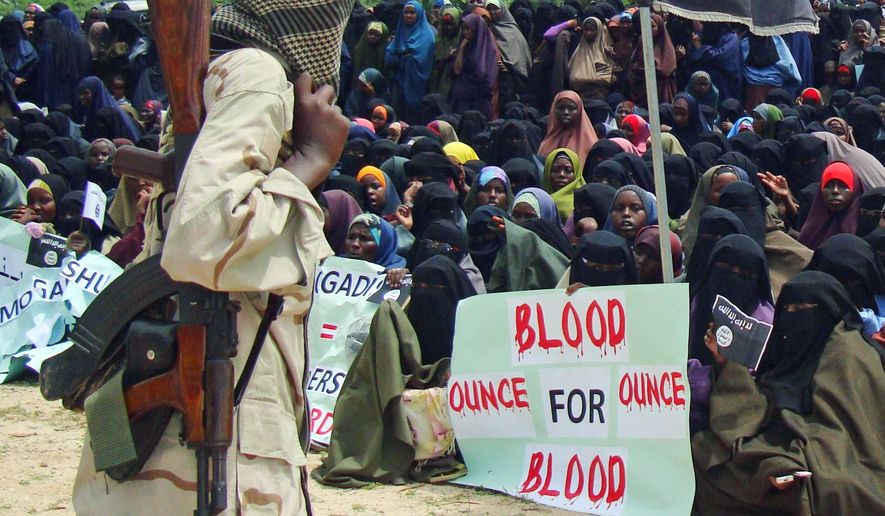MOGADISHU, Somalia | The Somali militants who formed the hard-line terrorist group al-Shabaab carried out their first suicide attack in 2006, during the height of violence in Iraq. The world hardly noticed.
This week, al-Shabaab became the world’s newest international terrorist group, after claiming twin blasts in Uganda’s capital, Kampala, that killed 76 people watching the televised World Cup final.
Ugandan officials on Tuesday showed off an unexploded suicide belt, suggesting the militants had hoped for a third explosion and more carnage. Ugandan officials arrested five people and hinted that Somali nationals were among those detained.
The FBI and Homeland Security Department warned in an assessment distributed to law enforcement personnel that if al-Shabaab — “the youth” in Arabic — is responsible for the blasts in Uganda, it could mean the group can attack in the U.S.
The fact that the al Qaeda-linked group carried out attacks far from its base in Mogadishu “does not bode well for other neighboring countries,” said Frank van Rooyen, a researcher at the South African Institute of International Affairs.
“One can expect them to start carrying out further terror attacks there,” Mr. van Rooyen said.
The 2006 suicide bombing targeted Somali President Abdullahi Yusuf Ahmed and was carried out by former members of the Islamic Courts Union, a Somali opposition group that attempted to restore order in Somalia after nearly two decades of lawlessness that resulted when warlords overthrew longtime dictator Siad Barre in 1991. But the ICU’s attempts at governance failed, and the group later gave rise to al-Shabaab.
Members of the ICU included top religious leaders and even Somalia’s current president, Sheik Sharif Sheik Ahmed.
But a year after the Islamic Court Union’s emergence, what initially appeared to be benign support for Islam turned into a radical interpretation of the religion, akin to the harsh brand practiced by Afghanistan’s Taliban regime. The ICU splintered, and the conservative militant wing gained power, forming al-Shabaab.
“The group was a member of the Islamic Courts Union, but it had always hidden their very extreme agenda. They were concentrating on trainings and arming themselves,” said Sheik Ahmed Siyad, a former ICU member.
Al-Shabaab battles African Union and Somali forces in the streets of Mogadishu daily, in an effort to topple Somalia’s weak, U.N.-backed administration. Those attacks often miss their military targets and the crossfire kills scores of civilians, a reason al-Shabaab cited in trying to justify the attacks in Uganda.
The group aims to install its conservative reading of Islam in Somalia. Music would be banned. Official punishments would include amputations and stonings.
Over the past two years, foreign fighters numbering in the low hundreds with experience in Afghanistan, Pakistan and Iraq have joined al-Shabaab, according to international officials, raising the group’s level of militant expertise. Somali-Americans have been recruited and taken part in suicide bombings.
Al-Shabaab members began pledging allegiance to al Qaeda last year, and one of its most famous members is known as Abu Mansour al-Amriki, or “the American.” He appeared in a jihadist video in May 2009.
But the group has long been on the U.S. radar. One of the group’s first top leaders, Aden Hashi Ayro, was killed in a U.S. airstrike in 2008. In September, a U.S. commando raid in rural southern Somalia killed Saleh Ali Saleh Nabhan, wanted for the 2002 car bombing of a beach resort in Kenya and an attempt to shoot down an Israeli airliner.
A Somali government intelligence official estimated al-Shabaab’s strength at between 3,000 and 7,000. The official, who asked not to be identified because of his job, said foreign fighters and young Somali recruits continue to swell the group’s ranks.
In Washington, an intelligence analysis dated Monday and obtained by the Associated Press on Tuesday said that U.S. citizens aligned with al-Shabaab could return to the United States, “possibly to carry out acts of violence.”
Intelligence officials previously considered the al Qaeda-affiliated group a threat to the U.S. In 2007 and 2008, about 20 Somali-American men were recruited and left the Minneapolis area to join al-Shabaab.
Al-Shabaab’s leader is Ahmed Abdi Mohamed Godane, who is best known as Abu Zubayr, a native of the breakaway region of Somaliland who once worked as an accountant with a telecommunications company. His group controls most of southern and central Somalia, including wide swaths of Mogadishu, the capital.
Sheik Ali Mohamud Rage, al-Shabaab’s spokesman, warned Monday that more attacks could be aimed at Uganda and Burundi, two countries with troops deployed to Mogadishu as part of the African Union peacekeeping force there. Analysts say Ethiopia, Kenya and Djibouti also could face attacks.
The head of Kenya’s anti-terrorism police, Nicholas Kamwende, said security forces have been put on high alert. An official in Burundi said the government has increased security.
“The government is taking the threats from al-Shabaab very seriously, and it is taking more preventive measures to curb any attack,” said Gervais Abayeho, an official in the Burundian president’s office.
The U.S. branded al-Shabaab a terrorist organization in 2008, more than a year after Ethiopia sent troops into Somalia and touched off an Islamist and nationalist insurgency that still rages.
Mr. Kamwende cited Fazul Abdullah Mohammed, who is wanted by the U.S. for the 1998 U.S. embassy bombings in Kenya and Tanzania and who is thought to be hiding in Somalia, as one of the top suspected al Qaeda members giving support to al-Shabaab.




Please read our comment policy before commenting.